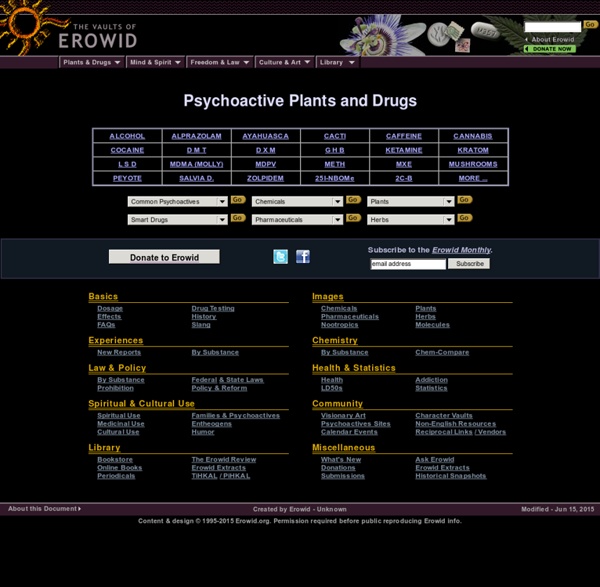



https://www.erowid.org/psychoactives/psychoactives.shtml
Essential First Aid Item: Activated Carbon Activated carbon, in powdered form, should be in every medicine cabinet and first aid kit. It is also known as activated charcoal. It is used around the world as a universal antidote for hundreds of poisons, including arsenic, mercury, pesticides, strychnine, warfarin, hemlock, E. Coli endotoxin, and gasoline. Over 4,000 chemicals, drugs, plant and microbial toxins, allergens, venoms, and wastes are effectively neutralized by activated charcoal, when it is given in sufficient quantities. Activated charcoal is also an effective detox for practically any drug overdose if administered in time.
Review of Galantamine: the Lucid Dreaming Pill So you’re considering the red pill… Galantamine has emerged as THE lucid dreaming pill. This natural supplement has been used for centuries in China as a memory enhancer, and was even noted by the ancient Greeks for its powerful mind-inducing effects. Now we know that galantamine indirectly promotes dreaming sleep as well as lucid dreaming, which is the art of becoming self-aware in your dreams. There’s a lot of hype about galantamine, so I want to cover the basics about how it works on the brain, the studies that have proven its effectiveness, and my personal recommendations for experimentation with this safe and natural supplement. I also want to be brutally honest about some of the mild psychological and physical side effects as well. Empathogen-entactogen The terms empathogen and entactogen are used to describe a class of psychoactive drugs that produce distinctive emotional and social effects similar to those of MDMA (ecstasy). Putative members of this class include 2C-B, 2C-I(at 2-14mg), MDMA, MDA, MDEA, MBDB and 6-APB among others. The chemical structure of many entactogens contains a substituted amphetamine core, and most belong to the phenethylamine class of psychoactive drugs, although several (AET and AMT) are tryptamines. When referring to MDMA and its counterparts, the term 'MDxx' is often used with the exception of MDPV.
What would happen if I drilled a tunnel through the center of th& Want to really get away from it all? The farthest you can travel from home (and still remain on Earth) is about 7,900 miles (12,700 kilometers) straight down, but you'll have to journey the long way round to get there: 12,450 miles (20,036 kilometers) over land and sea. Why not take a shortcut, straight down? You can get there in about 42 minutes -- that's short enough for a long lunch, assuming you can avoid Mole Men, prehistoric reptiles and underworld denizens en route. Granted, most Americans would end up in the Indian Ocean, but Chileans could dine out on authentic Chinese, and Kiwis could tuck into Spanish tapas for tea [sources: NOVA; Shegelski].
Tripping Stories!!Tell your favorite freaky tale.. Tripping Stories!!Tell your favorite freaky tale.. Hey Gang: From the reactions that were coming in on another post about ' tripping stories " I thought I would start a thread so everyone could contribute their own unique and no doubt hilarious stories about things that have happened while tripping/highly intoxicated..Anyone who did acid to any degree certainly has tales to relate...weird things always seemed to happen to those who had a tenuous grasp on reality at best..and it should make for interesting reading!! Peace!! I am reminded of an incident that happened back in the 70's..Me and my usual tripping buddy were driving thru Broward County in Florida and had to pull into a doughnut shop at about 3:30 am because we were peaking and could no longer navigate.
Drug profiles Drug profiles scientifically sound descriptions of drugs in the form of ‘drug profiles’. Presented in a standardised way, each profile briefly gives the chemistry, pharmacology, synthesis and precursors of each substance, as well as analysis, physical form (e.g. powder, tablet) and mode of use (e.g. ingested, snorted, injected). Most of the substances covered are controlled internationally by United Nations conventions. The profiles are available in German, English and French.
Pharmacology Vaults : Neuropharmacology of Hallucinogens : a technical overview, by BilZ0r (v3.1 Aug 2005) Please note that this subject is extremely technical and this article requires a background in brain science to fully understand. Some definitions of some key terms are included in the Definitions section of this artice. What are hallucinogens?
Episode 391: The Anti-Addiction Pill That's Big Business For Drug Dealers : Planet Money hide captionHeroin (left) and Suboxone (right) are both for sale on the street. Mara Zepeda/NPR Heroin (left) and Suboxone (right) are both for sale on the street. There's a pill called Suboxone that treats addiction to heroin and pain pills like oxycontin. Doctors and addicts say it's amazing. Does the Color Pink Exist? Scientists Arent Sure In a blog post, Robert Krulwich of the public radio show Radiolab noted that there is no pink in the colors of the rainbow. Pink is actually a combination of red and violet, two colors, which, if you look at a rainbow, are on the opposite sides of the arc. Remember the old colors of the rainbow mnemonic ROYGBIV? The R (red) is as far as it can get from V (violet). That’s where the trouble lies. Pink can’t exist in nature without a little rainbow-bending help, which would allow the shades of red and violet to commingle.
Drinking Games: Get Super-Drunk to Superbad God bless Judd Apatow for ushering in a new slate of R-rated comedies. We got trashed watching Katherine Heigl take it from Seth Rogan in Knocked Up earlier this year. Now, we’re going to offer a toast to Superbad. How much you’ll enjoy Superbad is in direct correlation to how much alcohol is in your system. And if you haven’t hit happy hour before the flick starts, you might find one of those classy theaters that serves cheap beer during the show.